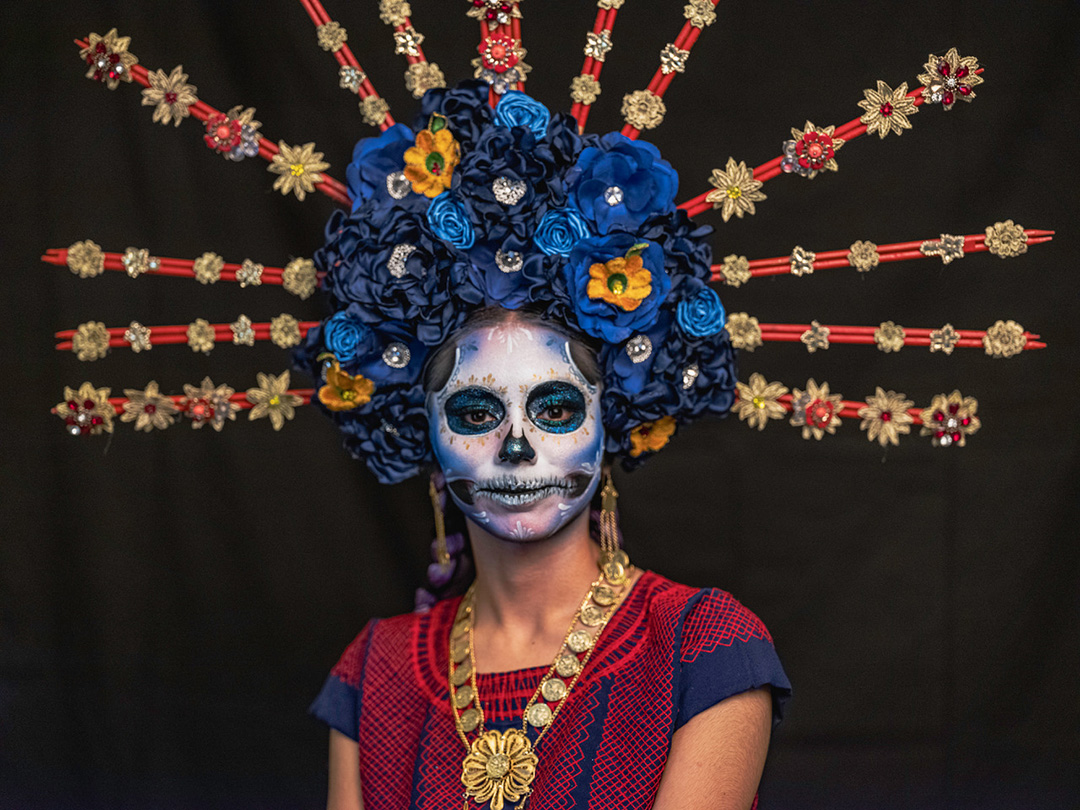In traditional society, the concept of jimat (a good luck charm) was nearly indispensable, as it would protect one against all kinds of evil that could befall a person. It could be in the form of text written on a piece of paper or linen. The belief in jimat continues in modern times. We know, for instance, how the Kellly bag transformed into a sort of a jimat for women of wealth lest they be acknowledged in
the high-class circles of society. This phenomenon has given rise to a pervasive sense of all- encompassing consumerism.
(Header photo: “LaCatrina, at La Dia de Los Muertos, Celebration in Mexico” by Hermandari Kartowisastro)
Story by Carla Bianpoen | Photos by Various Sources
The notion of jimat in Indonesian contemporary art is evident in several works of the late Sri Astari Rasjid (1953-2022) whose cultural orientation in creating contemporary art is well known, even during her tenure as Indonesia’s first female ambassador to Bulgaria, Macedonia and Albania. Illuminating her belief in the jimat, is one of her most iconic works titled Armors for the Soul. In 2011, when she felt the social and political situation was volatile, she became concerned about her well-being. She turned to the old belief in jimat and created her sculptural art installation of kebaya as Armors for the Soul (2011), using metaphors of flowers to symbolise a particular virtue that should protect her soul. On each kebaya, she placed a flower, be it a lily, lotus flower, a rose, jasmine or an anthurium.
In contemporary times, individuals of certain standing are often regarded as well- informed in the arts, and collecting artworks has, in many ways, become a means of safeguarding oneself against negative perceptions. Someone of a higher social class may feel compelled to demonstrate their knowledge of the art world by showcasing their collection of professionally renowned works.
The following are four more artists who are held in high esteem within the contemporary art circles.
Deden Hendan Durahman (b. 1974) is a graduate from the Visual Art and Design Department at the Bandung Institute of Technology. He also achieved the level of Meister at the Hochschule für Bildende Künste in Braunschweig, Germany, specialising in photography. His recent work, titled Shadow People, is part of an ongoing series exhibited beyond Indonesia. Deden utilises the reworked old technique of photogram, which does not involve a camera but relies on light-sensitive paper, to explore contemporary issues of identity and its fabrication. Despite its blurred appearance, the photogram technique, which creates images without a camera by using exposure to light and light-sensitive materials, infuses the image with a captivating aesthetic within an imaginative mystique. Deden currently teaches at his almamater in Bandung whilst continuing to explore photography as a visual art.
Different are the photographs created by Hermandari Kartowisastro, who embarked on her photography journey at the age of 68 and has since acquired the skills to travel across Indonesia and the wider world. Today, at the age of 80, she reflects on her photographic travels, covering 75 countries and 48 provinces in Indonesia. Whilst she has always had a passion for art, she regretted not being able to paint. However, her camera and photographic skills have allowed her to express her artistic emotions. She has captured hundreds of iconic images, never hesitating to face challenging circumstances to achieve the desired angle. The result is truly astonishing, whether it’s in her images of breathtaking landscapes, the grace of a soaring bird, or the iconic expressions of women in their everyday lives. Her ability to capture the nuances of facial features sometimes resembles a landscape of life itself.
Mujahidin Nurrahman (b. 1982) is an artist known for his delicate paper cuts that take the form of beautiful arabesques. However, upon closer inspection, these forms reveal the shapes of AK47 weaponry, which deceptively appear as mere ornaments. He explains that Islam is often accused of many things. His name, which means “Defender of Religion,” has been a stigma that has followed him from the earliest moments of his existence. This led him to search for the truth of his religion, deciphering its many layers, as revealed in his deceptively beautiful works. Some of his works, such as Strenuous, Vigorous, and Intense, were created to show how violence was intensifying. Mujahidin, who studied at the Bandung Institute of Technology in the Department of Visual Art and Design, is a recipient of the prestigious Bandung Art Award (BaCAA), and his works have captivated the public wherever he has exhibited, both locally and internationally.
Yani Mariani Sastranegara (b. 1955) graduated from the Jakarta Institute of
Art, majoring in sculpture. Her numerous exhibitions portray her as a prolific artist
with a deep connection to nature. While she excels in monumental works, such as Beyond the Tides, which still stands at The Green, she also creates smaller sculptures. Laras Semarak (2023) was inspired by the idea of togetherness and strength. Made with combstone resin, it initially appears as a poetic notion. However, upon closer examination, one can discern figures that have been rearranged to resemble a flower bouquet, with human legs serving as flower stalks.
